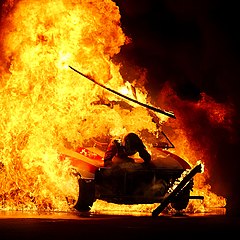|
Pyrotechnics Pyrotechnics is the science and craft of creating such things as fireworks, safety matches, oxygen candles, explosive bolts and other fasteners, parts of automotive airbags, as well as gas-pressure blasting in mining, quarrying, and demolition. This trade relies upon self-contained and self-sustained exothermic chemical reactions to make heat, light, gas, smoke and/or sound. The name comes from the Greek words pyr ("fire") and tekhnikos ("made by art").[1] Improper use of pyrotechnics could lead to pyrotechnic accidents. People responsible for the safe storage, handling, and functioning of pyrotechnic devices are known as pyrotechnicians. Proximate pyrotechnicsExplosions, flashes, smoke, flames, fireworks and other pyrotechnic-driven effects used in the entertainment industry are referred to as proximate pyrotechnics. Proximate refers to the pyrotechnic device's location relative to an audience. In the majority of jurisdictions, special training and licensing must be obtained from local authorities to legally prepare and use proximate pyrotechnics.   Many musical groups use pyrotechnics to enhance their live shows. Pink Floyd were innovators of pyrotechnic use in concerts. For instance, at the climax of their song "Careful with That Axe, Eugene", a blast of smoke was set off at the back of the stage. Bands such as the Who, KISS and Queen soon followed with use of pyrotechnics in their shows. Michael Jackson attempted using pyrotechnics in a 1984 Pepsi advertisement,[2] where a stray spark caused a small fire in his hair. German industrial metal band Rammstein are renowned for their incorporation of a large variety of pyrotechnics into performances,[citation needed] which range from flaming costumes to face-mounted flamethrowers. Nightwish, Lordi, Sabaton and Parkway Drive are also known for their vivid pyrotechnics in concert.[citation needed] Many professional wrestlers have also used pyrotechnics as part of their entrances to the ring. Modern pyrotechnics are, in general, divided into categories based upon the type of effect produced or manufacturing method. The most common categories are:[3]
Various ingredients may be added to pyrotechnic devices to provide colour, smoke, noise or sparks. Special additives and construction methods are used to modify the character of the effect produced, either to enhance or subdue the effect; for example, sandwiching layers of pyrotechnic compounds containing potassium perchlorate, sodium salicylate or sodium benzoate with layers that do not creates a fountain of sparks with an undulating whistle. In general, such pyrotechnic devices are initiated by a remotely controlled electrical signal that causes an electric match, or e-match, to produce ignition. The remote control may be manual, via a switch console, or computer controlled according to a pre-programmed sequence and/or a sequence that tracks the live performance via stage cues.  Display pyrotechnics Display pyrotechnics, also known as commercial fireworks, are pyrotechnic devices intended for use outdoors, where the audience can be further away, and smoke and fallout is less of a concern. Generally the effects, though often similar to proximate pyrotechnics, are of a larger size and more vigorous in nature. It will typically take an entire day to set up a professional fireworks display. This work is normally undertaken on temporarily secured locations by specialist companies employing teams of experienced pyrotechnicians. In modern times a familiar feature of larger fireworks displays are aerial shells, which commonly appear as large spherical bursts of stars in the sky. The exterior of these shells are commonly made of a hard paper-adhesive layered composite which holds the interior stars arranged around a burst charge, or other pyrotechnic effects. Aerial shells are fired out of mortars from the ground and have internal timing fuses that accurately and reliably position their bursts. A continuous sequence of shells are launched, often with effects artistically choreographed to music and themes, accompanied by various types of ground effects. Modern fireworks displays are commonly executed to a designed program using electrical wiring and ignition linked to an electronic firing system. The size of these fireworks can range from 50 mm (2") to over 600 mm (24") diameter depending on the type of effect and available distance from the audience. In most jurisdictions, special fireworks training and licensing must be obtained from local authorities to legally prepare and use display pyrotechnics. Consumer pyrotechnicsConsumer pyrotechnics are devices readily available for purchase to the general public with little or no special licensing or training. These items are considered relatively low hazard devices but, like all pyrotechnics, can still be hazardous and should be stored, handled and used appropriately. Some of the most common examples of consumer pyrotechnics encountered include recreational fireworks (including whistling and sparking types), model rocket motors, highway and marine distress flares, sparklers and caps for toy guns. Pyrotechnics are also indirectly involved in other consumer products such as powder actuated nail guns, ammunition for firearms, and modern fireplaces. Some types, including bird scarers, shell crackers, whistle crackers and flares, may be designed to be fired from a 12-gauge pistol or rifle. SafetyPyrotechnics are dangerous and must be handled and used properly. Recently, several high-profile incidents involving pyrotechnics have re-enforced the need to respect these explosives at all times.[citation needed] Proximate pyrotechnics is an area of expertise that requires additional training beyond that of other professional pyrotechnics areas and the use of devices specifically manufactured for indoor, close proximity use. Despite this, accidents can still happen due to the use of low-quality product, or due to an unexpected event, or even due to an error on the part of the operator. Homemade devices A common low-budget pyrotechnic flash pot is built using modified screw-in electric fuses in a common light fixture. The fuses are intentionally blown, acting as ignitors for a pyrotechnic material. Homemade devices may fail to include safety features and can provide numerous hazards, including:
Commercial flash pots include safety features such as warning pilot lamps, preignition grounding, and safing circuits. They also use isolated and low-voltage power sources, and have keyed power connections to help prevent accidental ignition. See alsoNotesReferences
External linksWikimedia Commons has media related to Pyrotechnics.
|